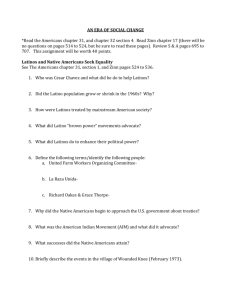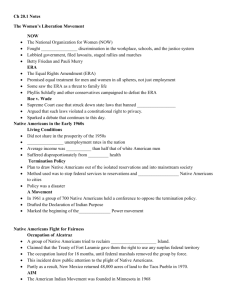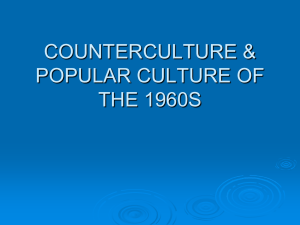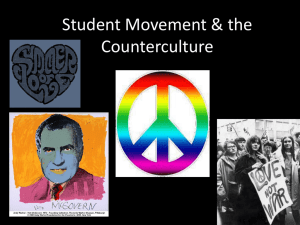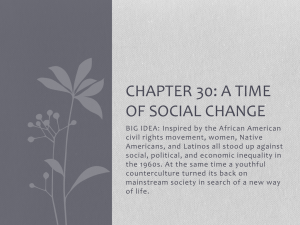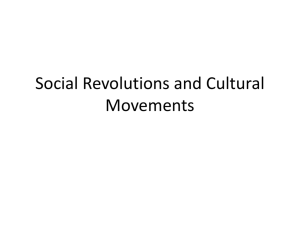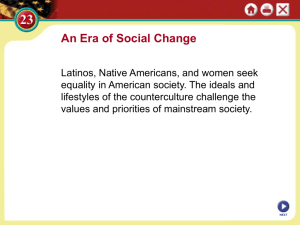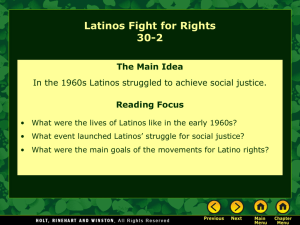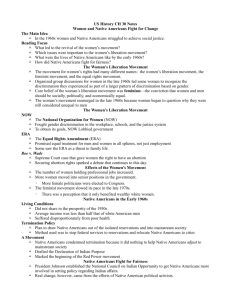Chapter 20 – A Time of Social Change Section Notes Video
advertisement
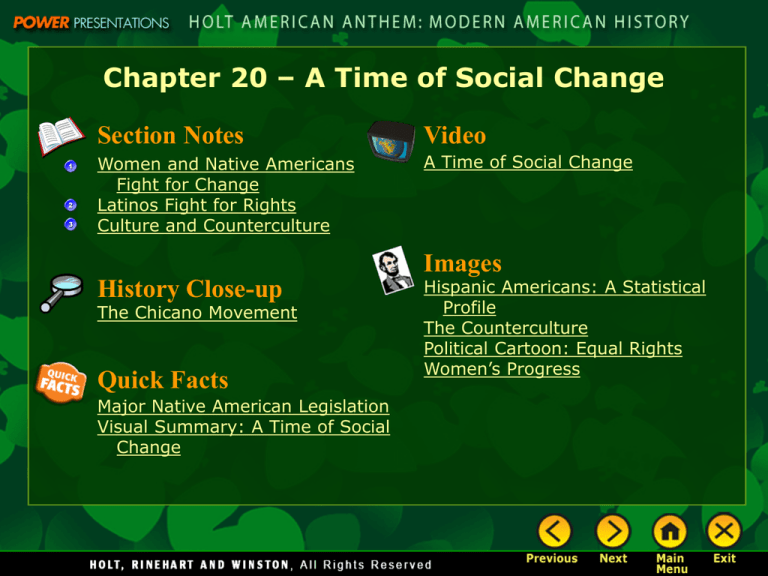
Chapter 20 – A Time of Social Change Section Notes Video Women and Native Americans Fight for Change Latinos Fight for Rights Culture and Counterculture A Time of Social Change History Close-up The Chicano Movement Quick Facts Major Native American Legislation Visual Summary: A Time of Social Change Images Hispanic Americans: A Statistical Profile The Counterculture Political Cartoon: Equal Rights Women’s Progress Women and Native Americans Fight for Change The Main Idea In the 1960s women and Native Americans struggled to achieve social justice. Reading Focus • What led to the revival of the women’s movement? • Which issues were important to the women’s liberation movement? • What were the lives of Native Americans like by the early 1960s? • How did Native Americans fight for fairness? The Women’s Liberation Movement • The movement for women’s rights had many different names: the women’s liberation movement, the feminist movement, and the equal rights movement. • Core belief of the women’s liberation movement was feminism—the conviction that women and men should be socially, politically, and economically equal. • Feminists cheered the passage of the Civil Rights Act of 1964, which banned discrimination in employment. • Still, fighting gender-based discrimination was given low priority. The Women’s Liberation Movement NOW ERA • The National Organization for Women (NOW) • The Equal Rights Amendment (ERA) • Fought gender discrimination in the workplace, schools, and the justice system • Promised equal treatment for men and women in all spheres, not just employment • Lobbied government, filed lawsuits, staged rallies and marches • Betty Friedan and Pauli Murry • Some saw the ERA as a threat to family life • Phyllis Schlafly and other conservatives campaigned to defeat the ERA Roe v. Wade • Supreme Court case that struck down state laws that banned abortion • Argued that such laws violated a constitutional right to privacy. • Sparked a debate that continues to this day. Effects of the Women’s Movement • The number of women holding professional jobs increased. • More women moved into senior positions in the government. – More female politicians were elected to Congress. • The feminist movement slowed its pace in the late 1970s. – There was a perception that it only benefited wealthy white women. Native Americans in the Early 1960s Living Conditions • Did not share in the prosperity of the 1950s • Highest unemployment rates in the nation • Average income was less than half that of white American men • Suffered disproportionately from poor health Termination Policy A Movement • Plan to draw Native Americans out of the isolated reservations and into mainstream society • In 1961 a group of 700 Native Americans held a conference to oppose the termination policy. • Method used was to stop federal services to reservations and relocate Native Americans to cities • Policy was a disaster • Drafted the Declaration of Indian Purpose • Marked the beginning of the Red Power movement Native Americans Fight for Fairness President Johnson established the National Council on Indian Opportunity to get Native Americans more involved in setting policy regarding Indian affairs. Real change, however, came from the efforts of Native American political activists. During the period of Red Power activism, Native Americans made important legislative gains. Congress passed laws that enhanced education, health care, voting rights, and religious freedom for Native Americans. Native Americans Fight for Fairness Occupation of Alcatraz AIM • A group of Native Americans tried to reclaim Alcatraz Island. • The American Indian Movement was founded in Minnesota in 1968 • Claimed that the Treaty of Fort Laramie gave them the right to use any surplus federal territory • Became the major force behind the Red Power movement • The occupation lasted for 18 months, until federal marshals removed the group by force. • This incident drew public attention to the plight of Native Americans. • Partly as a result, New Mexico returned 48,000 acres of land to the Taos Pueblo in 1970. • Called for a renewal of traditional cultures, economic independence, and better education for Indian children • Russell Means—one of AIM’s best-best known leaders • AIM sometimes used forceful tactics – the Trail of Broken Treaties – Occupation of Wounded Knee Other Organizations in the Fight for Fairness • National Indian Education Association—fought to improve access to education • Native American Rights Fund—provided legal services • Council on Energy Resource Tribes—helped its member nations gain control over their natural resources and choose whether to protect or develop them • These groups and others worked to protect Native Americans’ rights, improve standards of living, and do it all in a manner consistent with Native Americans’ cultures and traditions. Accessing the Progress of the Fight for Fairness Congress passed a number of laws in the 1970s to enhance education, health care, voting rights, and religious freedom for Native Americans. The Red Power movement instilled greater pride in Native Americans and generated wider appreciation of Native American culture. Despite these accomplishments, Native Americans continued to face many problems. Unemployment remained high and the high school dropout rate among Native Americans was the highest in the nation. Latinos Fight for Rights The Main Idea In the 1960s Latinos struggled to achieve social justice. Reading Focus • What were the lives of Latinos like in the early 1960s? • What event launched Latinos’ struggle for social justice? • What were the main goals of the movements for Latino rights? Latinos in the Early 1960s • More than 900,000 Latinos lived in the United States in 1960. A Latino is any person of Latin American descent. • One-third of Mexican American families lived below the poverty line and twice as many Mexican Americans as white Americans were unemployed. • Latinos faced discrimination in education. – Schools had less qualified teachers, fewer resources, and shabbier facilities. – Few teachers were able to speak Spanish. • In politics Latinos had far less power than the size of their population warranted. – Electoral district boundaries kept Latino votes scattered. – The number of Latinos in political office was very small. – Latinos were often excluded from serving on juries. Latinos’ Struggle for Social Justice Social Justice Delano Grape Strike César Chávez • Latinos sought social justice—the fair distribution of advantages and disadvantages in society. • Migrant agricultural workers, many of whom were Latino, received low wages for backbreaking labor. • In 1965 Filipino farmworkers went on strike in Delano, California. The National Farm Workers Association soon joined them. • He co-founded the National Farm Workers Association—a union of Mexican American farmworkers. • His leadership inspired many Mexican Americans to fight discrimination in their lives. The Delano Grape Strike • In 1965 Filipino farmworkers went on strike and demanded a 15cent increase in their hourly wage. • Dolores Huerta and César Chávez agreed to help. • Some 5,000 grape workers walked off their jobs. • The Delano Grape Strike lasted for five years. – Strikers picketed the fields. – Chávez led a 250-mile march to the state capital. – Huerta sent union activists around the nation to set up local boycott committees. – Union activists and sympathetic volunteers stood in front of grocery stores nationwide, urging Americans not to buy grapes. • The growers finally gave in and finally settled with the union. • The success of the strike made César Chávez a national figure. The Movement for Latino Rights Chicano Movement – A shortened form of mexicanos – Wanted to convey ethnic pride and commitment to political activism – Reies López Tijerina was an early Chicano leader who formed the Alianza Federal de Mercedes (Federal Alliance of Land Grants). – Rodolfo “Corky” Gonzales, another leading figure in the Chicano movement, founded the Crusade for Justice. – A group of college students in Texas formed the Mexican American Youth Organization (MAYO). – José Angel Gutiérrez founded La Raza Unida Party (RUP). – Working-class Chicano students in Los Angeles formed the Brown Berets, one of the most militant organizations in the Chicano movement. Movement for Latino Rights Alianza Crusade for Justice • Reies López Tijerina • Rodolfo “Corky” Gonzales • Focused on the enduring issue of land rights • Promoted Mexican American nationalism • Despite the Treaty of Guadalupe Hidalgo, Mexican Americans had lost thousands of acres over the years. • Provided legal aid, a theater for cultural awareness, a Spanish newspaper, and other community services • Rio Arriba County courthouse • Sponsored the National Chicano Liberation Youth Conference MAYO • José Angel Gutiérrez • Wanted to achieve economic independence for Mexican Americans, gain local control over the education of Hispanic children, and a third political party • Organized school walkouts and mass demonstrations • Crystal City, Texas Movement for Latino Rights La Raza Unida • Gutiérrez formed RUP (“the united people”) political party • Campaigned for bilingual education, improved public services, education for children of migrant workers, and an end to job discrimination • RUP candidates were elected to offices in several Texas cities. • RUP expanded into Colorado and other parts of the Southwest. • Disagreements among RUP leaders caused the party to fall apart in the late 1970s. Brown Berets • One of the most militant organizations in the Chicano movement • Began by protesting against police brutality in East Los Angeles • Fought for bilingual education, better school conditions, Chicano studies, and more Chicano teachers • Supported efforts of Chicanos to regain their historic lands, the National Farm Workers’ campaigns, and protested high number of Chicano deaths in Vietnam • Disbanded in 1972 Movement for Latino Rights Boricua Movement • Name by which many Puerto Ricans refer to themselves • Expresses ethnic pride and support for political activism • Many Puerto Ricans migrated to the United States after World War II. • Immigrants experienced social and economic discrimination. • Movement’s goals shifted to self-government for Puerto Rico and better conditions for all Puerto Ricans. • Young Lords—a militant boricua organization • Taller Boricua—community arts organization Cuban Americans • Many well-to-do Cubans fled Castro’s Communist government for the United States. • The majority of immigrants were professionals and business people. • Most Cuban Americans who organized for change were seeking changes for Cuba— the overthrow of Castro and communism. Culture and Counterculture The Main Idea The counterculture that emerged in the 1960s and 1970s left a lasting impact on American life. Reading Focus • What led to the rise of the counterculture? • What was life like in the counterculture? • How did mainstream American society react to the counterculture? • What legacy did the counterculture leave behind? The Rise of the Counterculture • The counterculture of the 1960s was a rebellion of teens and young adults against mainstream American society. • Young Americans believed that society’s values were hollow and its priorities were misplaced. • They called the mainstream the Establishment. • They wanted to create an alternative culture based on peace and love. Where did the counterculture come from? The number of teens and young adults in the United States rose dramatically in the 1960s. These young people were living in turbulent times: threat of nuclear war, racial discrimination and segregation, the Vietnam War, and environmental pollution. Rebellion against the dominant culture was not new. The Beat generation of the 1950s questioned traditional values, challenged authority, and experimented with nonconformist lifestyles. Rising Student Activism • Students on college campuses began rebelling against school policies they considered restrictive, unjust, or not relevant. • At the University of California at Berkeley students protested when school officials banned speech making and political organizing at the entrances to the campus. • The events at Berkeley marked the beginning of the Free Speech Movement, which swept campuses across the nation. • The students used the tactics of civil disobedience to protest injustices. • Mainstream Americans were shocked as they expected young people not to question authority. Life in the counterculture Counterculture Hippie Culture Decline • Thousands of teens and young adults left school, jobs, and traditional home life. • Sought new experiences • Rejected materialism and the work ethic of the older generation • Casual and colorful clothes • Freedoms often led to problems with addiction • Men began wearing longer hair, beards, or Afros. • No means of supporting themselves • Haight-Ashbury in San Francisco • Eastern religions, astrology, the occult, and illegal drugs • Flower children • Height of hippie movement was summer of 1967 (Summer of Love) • Lack of rules led to conflicts Mainstream Reactions to the Counterculture Some observers of the counterculture were put off by the unkempt appearance of hippies. On a deeper level, many mainstream Americans objected to the unconventional values of the counterculture. They saw hippies as disrespectful, uncivilized, and threatening. To many in the Establishment, it appeared that society was unraveling. The television show All in the Family highlighted the older generation’s distrust of the counterculture and the younger generation’s desire to change society. Legacy of the Counterculture Attitudes Art and Film Music • Americans became more casual in the way they dressed and more openminded about lifestyles and social behavior. • New style called pop art emerged. • The Beatles brought new techniques and ideas to rock and roll. • Aimed to appeal to popular tastes • Andy Warhol led the movement. • Attitudes about sexual behavior loosened. • Film broadened its subject matter as censorship rules relaxed. • People explored topics that were once taboo. • Film industry adopted a rating system. • Bob Dylan wrote political songs and became the spokesperson for his generation. • Woodstock Music and Art Fair was the celebration of an era. Click on the window to start video
